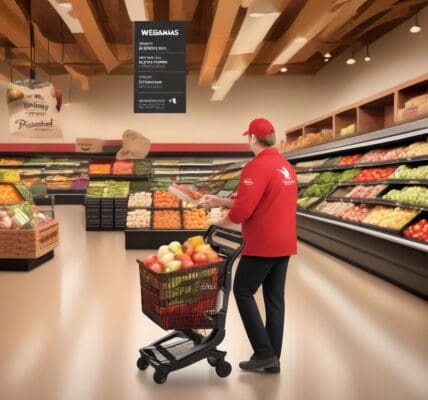Walmart has made notable strides in expanding its e-grocery services, particularly among affluent shoppers. A recent study by Brick Meets Click and Mercatus sheds light on this shift, indicating that the retail giant is successfully attracting consumers from higher income brackets.
The report shows that households earning over $200,000 annually contributed to an impressive 8% growth in Walmart’s e-grocery sales during the first half of its fiscal year, significantly outpacing the 4% growth in Walmart’s overall active user base. This trend is notable since Walmart traditionally served a customer base primarily composed of lower-income households. David Bishop, a partner at Brick Meets Click, highlighted this shift, stating, “Walmart’s growth in households making $200,000+ per year shows that the ‘flight to value’ has even affected how this income group shops for groceries.”
The research emphasizes that affluent households shopping at Walmart spend 1.5 times more monthly than those in lower-income brackets. This statistic makes these high-income consumers a highly desirable segment for the retailer to target.
In contrast, lower-income households—defined as those earning less than $50,000—saw a decline in grocery purchases, dropping 6% during the same period. This downturn was not isolated to Walmart; data indicate that e-commerce grocery sales suffered similarly across supermarkets and competitors like Target, which experienced a staggering 20% drop.
Further analysis reveals that while Walmart’s sales remained steady, other retail formats like traditional supermarkets and hard discounters recorded sales declines in early 2024. This performance disparity highlights Walmart’s resilience in the face of a challenging retail landscape. Mark Fairhurst, Chief Growth Officer at Mercatus, pointed out that regional retailers may be at risk of losing affluent customers to Walmart unless they enhance their value propositions. He noted, “To retain existing affluent shoppers and possibly attract others, grocers need to strengthen their value propositions by offering unique products, personalized promotions, exceptional service, and enhanced digital experiences.”
Walmart’s commitment to understanding consumer behavior is reflected in its impressive foot traffic and online reach. Approximately 255 million customers visit Walmart’s over 10,500 stores and e-commerce platforms across 19 countries each week. With a fiscal year 2024 revenue projected at $648 billion and a workforce of around 2.1 million associates globally, Walmart continues to assert its dominance in the food retail sector, landing at the top of Progressive Grocer’s 2024 list of leading food and consumables retailers.
As the grocery industry evolves, the ability to attract and retain higher-income shoppers will represent both challenges and opportunities for retailers. The data indicates a clear trend towards e-commerce preferences among affluent households, suggesting that future strategies should prioritize digital engagement and tailored shopping experiences.
For companies looking to mirror Walmart’s success, the focus must be on creating robust e-commerce platforms that cater to the unique needs of diverse consumer demographics. Understanding shopping behaviors will be critical to driving growth in an increasingly online market.
The landscape of grocery retail is shifting, and the ability to adapt to these changes will define the winners in the market. As Walmart demonstrates through its e-grocery success, aligning product offerings, pricing strategies, and customer service with evolving consumer expectations is essential for sustained growth.
Walmart’s experience serves as a vital case study for the retail industry, illustrating that reaching higher-income shoppers through innovative e-commerce solutions can yield significant rewards. The implications of this shift are profound and suggest a turning point for the grocery sector, prompting a reevaluation of strategies across all retail formats.












